No two people are the same when it comes to need and preference. The same goes for when selecting the right hearing aid.
GETTING THE RIGHT HEARING AID
“For a lot of individuals who use hearing aids, appearance plays a crucial role. Whether you opt for a hearing aid that rests behind the ear or one that fits inside the ear canal, contemporary hearing aids have come a long way from the bulky, beige, and squealing devices your grandfather may have worn. They now feature discreet and sleek casings that house sophisticated miniature computers.”


Your hearing care professional will help you to make the right choice for you. After the hearing test, your hearing care professional will interview you about your needs, preferences and requirements when it comes to your hearing and your hearing aid. The purpose is to find the right hearing aid solution to match your lifestyle and what is most important to you. All this to give you the best possible hearing in all the many situations you face in your daily life.
FACTORS TO CONSIDER
- Profound hearing loss: If you have profound hearing loss, your hearing care professional will most likely recommend a Behind-the-ear (BTE) hearing aid.
- Narrow ear canals: If you have narrow ear canals, your hearing care professional will probably recommend a BTE hearing aid.
- Listening situations: Hearing aids are available in variety of technology levels. Make sure to review the different features with the listening environments you are in the most.
- Visibility concerns: Completely-in-canal (CIC) are the smallest hearing aids on the market.
- Vision and dexterity: A hearing aid remote control can help you handle the small In-the-ear hearing aids or CIC, if you have challenges with your dexterity or your vision.
- Budget: Most of our hearing aid models are available in three “levels of advancement”. The price of your hearing aids depends on how advanced the hearing aid technology is.
